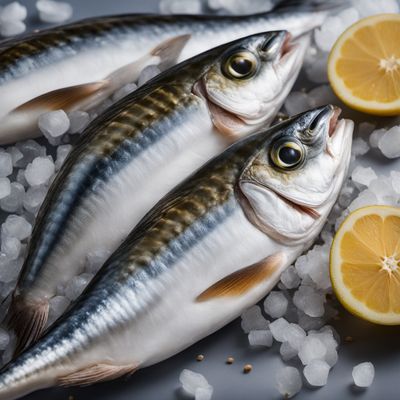
Ingredient
Mackerel, indian
The Exotic Indian Mackerel
Indian mackerel is a small to medium-sized fish with a streamlined body and silver-blue scales. It has a rich, oily flesh that is firm and flavorful. The taste of Indian mackerel is distinctively strong and slightly salty, with a hint of sweetness. The texture is tender and flakes easily when cooked. Its appearance is marked by its vibrant silver-blue color and dark, wavy lines along the back and sides.
Origins and history
Indian mackerel is native to the Indian Ocean and is commonly found along the coasts of India, Sri Lanka, and other Southeast Asian countries. It has been a staple food in these regions for centuries and is an integral part of the local cuisine. Indian mackerel is highly valued for its nutritional content and is considered a good source of omega-3 fatty acids, vitamins, and minerals. It is often caught using traditional fishing methods, such as nets and lines, and is also commercially farmed in some areas.
Nutritional information
Indian mackerel is a good source of protein, omega-3 fatty acids, vitamin D, and calcium. It is also low in saturated fat and calories, making it a healthy choice for seafood lovers. However, due to its high mercury content, it is recommended to consume Indian mackerel in moderation, especially for pregnant women and young children.
Allergens
May contain fish allergens.
How to select
When selecting Indian mackerel, look for fish that have clear, bright eyes, shiny skin, and a fresh, mild aroma. The flesh should be firm and spring back when pressed. Avoid fish that have a strong, fishy odor or signs of discoloration. If purchasing frozen mackerel, ensure that it is properly sealed and free from ice crystals.
Storage recommendations
To maintain its freshness, store fresh Indian mackerel in the refrigerator at a temperature between 32°F and 38°F (0°C and 3°C). If frozen, store in airtight containers or freezer bags to prevent freezer burn. Once thawed, consume within 1-2 days. Cooked mackerel can be stored in the refrigerator for up to 3 days.
How to produce
Indian mackerel can be caught using traditional fishing methods, such as nets and lines. It can also be commercially farmed in suitable coastal areas. To produce Indian mackerel at home, you would need access to a saltwater body, fishing equipment, and knowledge of fishing techniques.
Preparation tips
Indian mackerel can be prepared in various ways, including frying, grilling, baking, or steaming. It is commonly used in curries, pickles, and fried preparations. To enhance its flavor, marinate the fish in a mixture of spices, such as turmeric, chili powder, and cumin, before cooking. When frying, cook until the skin is crispy and the flesh is opaque and flakes easily. Avoid overcooking, as it can result in a dry texture.
Culinary uses
Indian mackerel is commonly used in Indian cuisine, particularly in curries, pickles, and fried preparations. It pairs well with spices and aromatic ingredients, adding depth and flavor to the dishes. It is also enjoyed as a grilled or fried fish, served with rice and vegetables.
Availability
Indian mackerel is commonly available in India, Sri Lanka, and other Southeast Asian countries.

